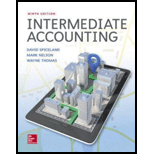
Concept explainers
(1)
Present Value:
The value of today’s amount to be paid or received in the future at a compound interest rate is called as present value. The following formula is used to calculate the present value of an amount:
Future Value: The future value is value of present amount compounded at an interest rate until a particular future date. The future value of an amount is calculated by using the following formula:
The present value of the pension obligation to three employees as of December 31, 2018.
(1)
Present Value:
The value of today’s amount to be paid or received in the future at a compound interest rate is called as present value. The following formula is used to calculate the present value of an amount:
Future Value: The future value is value of present amount compounded at an interest rate until a particular future date. The future value of an amount is calculated by using the following formula:
Explanation of Solution
- For Employee T:
Determine the present value of an ordinary annuity.
PV factor (Present value of an ordinary annuity of $1: n = 15, i = 11%) is taken from the table value (Table 4 in Appendix from textbook).
Determine the present value.
PV factor (Present value of $1: n = 2, i = 10%) is taken from the table value (Table 2 in Appendix from textbook).
- For Employee E:
Determine the present value of an ordinary annuity.
PV factor (Present value of an ordinary annuity of $1: n = 15, i = 11%) is taken from the table value (Table 4 in Appendix from textbook).
Determine the present value.
PV factor (Present value of $1: n = 3, i = 11%) is taken from the table value (Table 2 in Appendix from textbook).
- For Employee C:
Determine the present value of an ordinary annuity.
PV factor (Present value of an ordinary annuity of $1: n = 15, i = 11%) is taken from the table value (Table 4 in Appendix from textbook).
Determine the present value.
PV factor (Present value of $1: n = 4, i = 11%) is taken from the table value (Table 2 in Appendix from textbook).
Thus, following are the present values of the pension obligation of the three employees.
| Employees | Present values ($) |
| T | 116,725 |
| E | 131,447 |
| C | 142,105 |
Table (1)
(2)
To compute: The annual contribution.
(2)
Explanation of Solution
Determine the present value of pension obligation as of December 31, 2021.
| Employee |
PV as of December 31, 2018 | x | FV of $1 factor, | = |
FV as of December 31, 2018 |
| n = 3, i = 11% | |||||
| T | $116,725 | x | 1.36763 | = | $159,637 |
| E | 131,448 | x | 1.36763 | = | 179,772 |
| C | 142,105 | x | 1.36763 | = | 194,347 |
| Total present value, December 31, 2021 | $533,756 | ||||
Table (2)
Compute the annual contribution using future value of annuity due.
FV factor (Future value of an annuity due of $1: n =3, i =11%) is taken from the table value (Table 5 in Appendix from textbook).
Hence, the first contribution that will be made on December 31, 2016 is $143,881.
Want to see more full solutions like this?
Chapter 6 Solutions
Intermediate Accounting
- I am looking for a step-by-step explanation of this financial accounting problem with correct standards.arrow_forwardI need help with this general accounting question using standard accounting techniques.arrow_forwardCan you help me solve this general accounting problem with the correct methodology?arrow_forward
- I am trying to find the accurate solution to this general accounting problem with appropriate explanations.arrow_forwardCan you help me solve this general accounting question using valid accounting techniques?arrow_forwardI need the correct answer to this general accounting problem using the standard accounting approach.arrow_forward
- Please explain the solution to this general accounting problem using the correct accounting principles.arrow_forwardConsider how the role of accountants has changed over time. Just a few short decades ago, many accountants were writing down by hand each business transaction into a general journal, manually posting to the general ledger, and physically adding ledger figures to construct trial balances and financial statements. Imagine how many people it took to perform these processes and then imagine how many organizations needed these people.” Accounting is changing once again. The relentless adoption of new technology continues to increase the automation of routine processes that accountants have performed for centuries… While this reality of machine learning and artificial intelligence could be perceived as a threat to the accounting profession, it should instead be seen as an opportunity: accountants can once again shed the responsibility for mundane, time-consuming transactions and focus instead on value-added activities. Accountants can leverage their newfound time into driving business…arrow_forwardDefine working capital and explain its importance in financial health and liquiditymanagement.2. Assess how the matching concept and accrual basis affect the reporting ofcurrent assets and liabilities.3. Using a hypothetical balance sheet (you may create one), identify at least 5current assets and 5 current liabilities and analyze how changes in theseelements affect liquidity ratios.4. Recommend at least two strategies to optimizeworking capital.arrow_forward

 AccountingAccountingISBN:9781337272094Author:WARREN, Carl S., Reeve, James M., Duchac, Jonathan E.Publisher:Cengage Learning,
AccountingAccountingISBN:9781337272094Author:WARREN, Carl S., Reeve, James M., Duchac, Jonathan E.Publisher:Cengage Learning, Accounting Information SystemsAccountingISBN:9781337619202Author:Hall, James A.Publisher:Cengage Learning,
Accounting Information SystemsAccountingISBN:9781337619202Author:Hall, James A.Publisher:Cengage Learning, Horngren's Cost Accounting: A Managerial Emphasis...AccountingISBN:9780134475585Author:Srikant M. Datar, Madhav V. RajanPublisher:PEARSON
Horngren's Cost Accounting: A Managerial Emphasis...AccountingISBN:9780134475585Author:Srikant M. Datar, Madhav V. RajanPublisher:PEARSON Intermediate AccountingAccountingISBN:9781259722660Author:J. David Spiceland, Mark W. Nelson, Wayne M ThomasPublisher:McGraw-Hill Education
Intermediate AccountingAccountingISBN:9781259722660Author:J. David Spiceland, Mark W. Nelson, Wayne M ThomasPublisher:McGraw-Hill Education Financial and Managerial AccountingAccountingISBN:9781259726705Author:John J Wild, Ken W. Shaw, Barbara Chiappetta Fundamental Accounting PrinciplesPublisher:McGraw-Hill Education
Financial and Managerial AccountingAccountingISBN:9781259726705Author:John J Wild, Ken W. Shaw, Barbara Chiappetta Fundamental Accounting PrinciplesPublisher:McGraw-Hill Education





